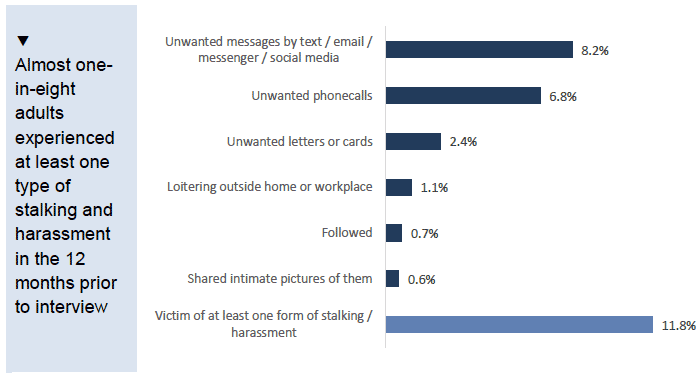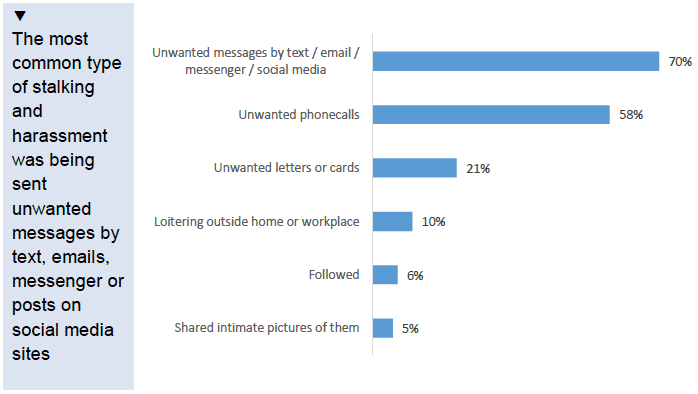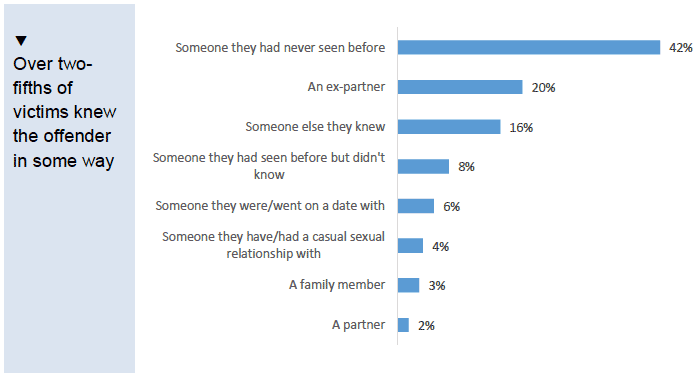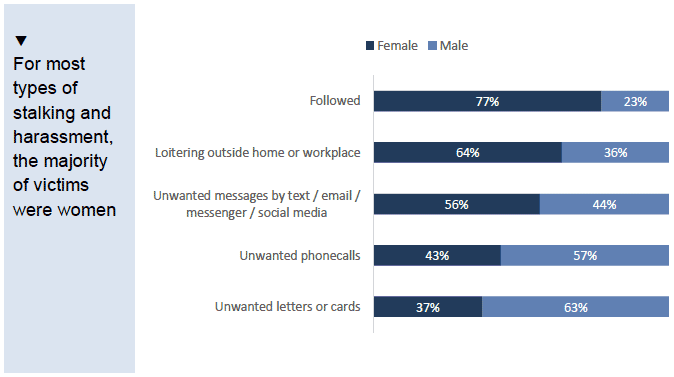Scottish Crime and Justice Survey 2019/20: main findings
Main findings from the Scottish Crime and Justice Survey 2019/2020, including self-completion findings covering the period 2018/19 to 2019/20.
This document is part of a collection
9.2 Stalking and harassment
Respondents of the SCJS are asked about their experiences of stalking and harassment in the 12 months prior to interview, including victim-offender relationships and reporting to the police.
Further results on experiences of harassment and discrimination (based on questions in the main survey about being insulted, pestered or intimidated) are provided in an earlier section of this report.
The stalking and harassment self-completion module of the SCJS asks respondents if they have experienced, more than once, one or more of the following types of incidents:
- being sent unwanted letters or cards on a number of occasions
- being sent unwanted messages by text, emails, messenger or posts on social media sites on a number of occasions
- receiving a number of unwanted phone calls
- having someone loitering outside their home or workplace on more than one occasion
- being followed on more than one occasion
The SCJS also asks respondents if anyone has shared intimate images of them without their consent for example, by text, on a website, or on a social media site - sometimes known as 'revenge porn'.[148]
The questions in the SCJS differ from the official legislation which defines stalking as an offence.[149] This chapter however provides information on the behaviours outlined above, each of which can be viewed as a form of stalking and harassment. The data does not show whether respondents themselves viewed their experiences as stalking or harassment; some respondents may also have included incidents which would not be classed as stalking and harassment, for example, potentially, receiving cold-calling sales phone calls.
The figures in this section refer to the two years 2018/19 and 2019/20 combined. This is referred to throughout the chapter as 2018/20. For more information, see the Technical Report.
The stalking and harassment questions in the SCJS were updated with effect from 2016/17 in order to improve the quality of the data collected, and make the data more useful for capturing the different types of stalking and harassment that people experience. Where relevant, examination of changes over time compares the latest findings with the last self-completion results from 2016/18.[150]
What can the 2018/20 SCJS results tell us about stalking and harassment in Scotland?
In the 12 months prior to interview, 11.8% of adults experienced at least one type of stalking and harassment.
Almost one-in-eight adults (11.8%) experienced at least one type of stalking and harassment in the year prior to interview, unchanged from 2016/18. Over the same period 6.1% experienced more than one type.
Figure 9.3 below shows the percentage of respondents who experienced the different forms of stalking and harassment in the 12 months prior to interview in 2018/20.

Base: All respondents (9,600). Variables: SH_02; SH_03.
What can the 2018/20 SCJS results tell us about the types of stalking and harassment most commonly experienced?
The most common type of stalking and harassment reported in the SCJS was being sent unwanted messages by text, email, messenger or posts on social media sites.
Figure 9.4 shows the distribution of different types of stalking and harassment amongst those who experienced at least one form of stalking and harassment. The most common type involved being sent unwanted messages by text, email, messenger or posts on social media sites. This was experienced by 70% of all those who had experienced at least one form of stalking and harassment, unchanged from 2016/18.

Base: All respondents experiencing at least one type of stalking & harassment in the 12 months prior to interview (1,050). Variables: SH_02; SH_03.
Over two-fifths of victims knew the offender in some way.
The relationship between victims and offenders is not always straightforward. Over two-fifths (44%) of respondents who experienced at least one form of stalking and harassment in the 12 months prior to interview reported having known the offender(s) in some way. This is a decrease from 50% in 2016/18. A similar proportion (42%) in 2018/20 said the offender was someone they had never seen before.
One of the most common ways in which an offender was known to a victim was because they were their ex-partner (20%).
'Ex-partner' was included in the questionnaire for the first time as a separate category of relationship between the victim and offender(s) in 2018/19. Therefore, it is advised that these results should not be compared to the 2016/18 figures (other than the category of 'someone I had never seen before' and the derived measure of 'known in some way' which are unaffected by the question change). This will be monitored in future, with the 2018/20 results from the updated question used as a baseline for comparisons.
Of those who had experienced more than one form of stalking and harassment in the 12 months prior to interview, 36% said that the same offender was involved, unchanged from 2016/18.
Figure 9.5 below shows the relationship between the victim and offender(s) in relation to the most recent incident of stalking or harassment in the 12 months prior to interview.

Base: All respondents experiencing at least one type of stalking & harassment in the 12 months prior to interview (1,050). Variable: SH_2.
The police were informed about the most recent incident in around one-in-ten cases.
Respondents who had experienced at least one incident of stalking and harassment in the 12 months prior to interview were asked if the police were informed about the most recent incident.[151] Of these respondents, just under one-in-ten (9%) said that the police came to know about the most recent incident, unchanged from 2016/18.
Women were almost twice as likely than men to report the most recent incident to the police (12% and 6%, respectively). This is a change compared to the position in 2016/18 where there was no significant difference detected between the proportion of men and women who reported the most recent incident to the police.
The most common reason for not reporting the most recent incident to the police was that the respondent felt the incident was too trivial/not worth reporting (44%), followed by the victim dealing with the incident themselves (29%), unchanged from 2016/18.
Are some population groups more likely to have experienced stalking and harassment?
Experiences of stalking and harassment varied by age group and victim status in the main questionnaire.[152] Table 9.3 below shows the varying proportion of respondents experiencing at least one form of stalking and harassment in the 12 months prior to interview, by respondent characteristics. Any statistically significant changes between 2016/18 and 2018/20 are commented below, however for the majority of groups there was no change.
| Characteristics | % of adults | Base | |
|---|---|---|---|
| Gender | Male | 11.4% | 4,360 |
| Female | 12.1% | 5,240 | |
| Age | 16-24 | 20.9% | 680 |
| 25-44 | 13.8% | 2,750 | |
| 45-59 | 10.2% | 2,520 | |
| 60 and over | 7.4% | 3,650 | |
| Victim status | Victim | 17.7% | 1,060 |
| Non-victim | 11.0% | 8,540 | |
| Area deprivation | 15% most deprived | 12.4% | 1,310 |
| Rest of Scotland | 11.7% | 8,280 | |
| Rurality | Urban | 11.9% | 7,830 |
| Rural | 10.8% | 1,770 | |
| All adults | 11.8% | 9,600 |
Variables: SH_02, SH_03.
Gender
The survey found no difference in the proportion experiencing stalking and harassment in the 12 months prior to interview for men and women (11.4% and 12.1%, respectively).
Looking at the gender split by type of stalking and harassment, more women than men reported being followed (1.1% compared to 0.3%, respectively) or receiving unwanted messages by text, email, messenger or posts on social media sites (9.0% compared to 7.4%, respectively). Conversely, more men than women reported receiving unwanted letters or cards (3.2% compared to 1.7%, respectively) or unwanted phone calls (8.0% compared to 5.7%, respectively).
Figure 9.6 below shows the gender split of those who experienced each of the types stalking and harassment.[153]

Base: All respondents, in the 12 months prior to interview, experiencing loitering outside their home or workplace (120); being followed (70); unwanted phone calls made (620); sent unwanted letters or cards (220); sent you unwanted messages by text, email, messenger, or posts on social media sites (710). Variable: SH_02.
Note that having intimate pictures of themselves shared online without their consent is not included in this due to the small number of respondents reporting this.
Age
Experiences of at least one form of stalking and harassment were higher amongst those aged 16 to 24 (20.9%) than any other age group.
The results have also been broken down by both age and gender together, as notable differences in experience of stalking and harassment between genders within different age groups were expected. These figures can be found in full in the online data tables (for this finding and a range of other measures across the survey).
Experiences of stalking and harassment were higher among women aged 16 to 24 (25.6%), compared to men of the same age (16.3%).
Victim status
Those who reported being a victim of a crime in the main survey were more likely to report having experienced stalking and harassment. 17.7% of those who reported being a victim in the main survey also experienced stalking and harassment, compared to 11.0% of those who did not report themselves as victims in the main survey.
Area deprivation
There was no difference in the proportion experiencing stalking and harassment between those living in the 15% most deprived areas and the rest of Scotland (12.4% and 11.7%, respectively).
Rurality
There was no difference detected in the likelihood of experiencing stalking and harassment by urban and rural locations (11.9% and 10.8%, respectively), although the proportion of respondents in rural areas increased between 2016/18 and 2018/20 (from 8.1% to 10.8%).
Contact
Email: scjs@gov.scot
There is a problem
Thanks for your feedback